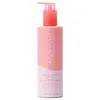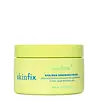What's inside
What's inside
 Key Ingredients
Key Ingredients

 Benefits
Benefits

 Concerns
Concerns

 Ingredients Side-by-side
Ingredients Side-by-side

Water
Skin ConditioningCaprylic/Capric Triglyceride
MaskingIsopropyl Palmitate
EmollientHelianthus Annuus Seed Oil
EmollientCocos Nucifera Oil
MaskingStearic Acid
CleansingGlycerin
HumectantCetearyl Alcohol
EmollientCoco-Caprylate/Caprate
EmollientPolysorbate 60
EmulsifyingRicinus Communis Seed Oil
MaskingShea Butter Ethyl Esters
EmollientParfum
MaskingPhenoxyethanol
PreservativePropanediol
SolventXanthan Gum
EmulsifyingTocopherol
AntioxidantEthylhexylglycerin
Skin ConditioningAloe Barbadensis Leaf Juice
Skin ConditioningSodium Hydroxide
BufferingTetrasodium Glutamate Diacetate
Sclerotium Gum
Emulsion StabilisingCaprylyl Glycol
EmollientHexylene Glycol
EmulsifyingChamomilla Recutita Flower Extract
MaskingCocos Nucifera Fruit Extract
EmollientRosa Canina Seed Extract
EmollientWater, Caprylic/Capric Triglyceride, Isopropyl Palmitate, Helianthus Annuus Seed Oil, Cocos Nucifera Oil, Stearic Acid, Glycerin, Cetearyl Alcohol, Coco-Caprylate/Caprate, Polysorbate 60, Ricinus Communis Seed Oil, Shea Butter Ethyl Esters, Parfum, Phenoxyethanol, Propanediol, Xanthan Gum, Tocopherol, Ethylhexylglycerin, Aloe Barbadensis Leaf Juice, Sodium Hydroxide, Tetrasodium Glutamate Diacetate, Sclerotium Gum, Caprylyl Glycol, Hexylene Glycol, Chamomilla Recutita Flower Extract, Cocos Nucifera Fruit Extract, Rosa Canina Seed Extract
Water
Skin ConditioningCocos Nucifera Oil
MaskingCaprylic/Capric Triglyceride
MaskingStearyl Alcohol
EmollientPolyglyceryl-2 Stearate
EmulsifyingGlycerin
HumectantOlus Oil
EmollientButyrospermum Parkii Butter
Skin ConditioningCaprylyl Caprylate/Caprate
EmollientPropanediol
SolventGlyceryl Stearate
EmollientVaccinium Myrtillus Fruit Extract
Skin ConditioningBetaine
HumectantMicrocitrus Australasica Fruit Extract
Saccharum Officinarum Extract
MoisturisingCitrus Aurantium Dulcis Fruit Extract
MaskingCitrus Limon Fruit Extract
MaskingSalix Nigra Bark Extract
Skin ProtectingHelianthus Annuus Extract
EmollientPrunus Amygdalus Dulcis Oil
Skin ConditioningAcer Saccharum Extract
Skin ConditioningRosmarinus Officinalis Leaf Extract
AntimicrobialSimmondsia Chinensis Seed Oil
EmollientVitis Vinifera Seed Oil
EmollientTrisodium Ethylenediamine Disuccinate
Aloe Barbadensis Leaf Juice
Skin ConditioningOryza Sativa Bran Extract
Skin ConditioningPanthenol
Skin ConditioningTocopherol
AntioxidantAllantoin
Skin ConditioningXanthan Gum
EmulsifyingBisabolol
MaskingEthylhexylglycerin
Skin ConditioningSodium Hydroxide
BufferingPhenoxyethanol
PreservativePotassium Sorbate
PreservativeCitric Acid
BufferingWater, Cocos Nucifera Oil, Caprylic/Capric Triglyceride, Stearyl Alcohol, Polyglyceryl-2 Stearate, Glycerin, Olus Oil, Butyrospermum Parkii Butter, Caprylyl Caprylate/Caprate, Propanediol, Glyceryl Stearate, Vaccinium Myrtillus Fruit Extract, Betaine, Microcitrus Australasica Fruit Extract, Saccharum Officinarum Extract, Citrus Aurantium Dulcis Fruit Extract, Citrus Limon Fruit Extract, Salix Nigra Bark Extract, Helianthus Annuus Extract, Prunus Amygdalus Dulcis Oil, Acer Saccharum Extract, Rosmarinus Officinalis Leaf Extract, Simmondsia Chinensis Seed Oil, Vitis Vinifera Seed Oil, Trisodium Ethylenediamine Disuccinate, Aloe Barbadensis Leaf Juice, Oryza Sativa Bran Extract, Panthenol, Tocopherol, Allantoin, Xanthan Gum, Bisabolol, Ethylhexylglycerin, Sodium Hydroxide, Phenoxyethanol, Potassium Sorbate, Citric Acid
Ingredients Explained
These ingredients are found in both products.
Ingredients higher up in an ingredient list are typically present in a larger amount.
Aloe Barbadensis Leaf Juice comes from leaves of the aloe plant. Aloe Barbadensis Leaf Juice is best known for helping to soothe sunburns. It is also anti-inflammatory, moisturizing, antiseptic, and can help heal wounds.
Aloe is packed with good stuff including Vitamins A, C, and E. These vitamins are antioxidants, which help fight free-radicals and the damage they may cause. Free-radicals are molecules that may damage your skin cells, such as pollution.
Aloe Barbadensis Leaf Juice also contains sugars. These sugars come in the form of monosaccharides and polysaccharides, folic acid, and choline. These sugars are able to help bind moisture to skin.
It also contains minerals such as calcium, 12 anthraquinones, fatty acids, amino acids, and Vitamin B12.
Learn more about Aloe Barbadensis Leaf JuiceThis ingredient is an emollient, solvent, and texture enhancer. It is considered a skin-softener by helping the skin prevent moisture loss.
It helps thicken a product's formula and makes it easier to spread by dissolving clumping compounds.
Caprylic Triglyceride is made by combining glycerin with coconut oil, forming a clear liquid.
While there is an assumption Caprylic Triglyceride can clog pores due to it being derived from coconut oil, there is no research supporting this.
Learn more about Caprylic/Capric TriglycerideCocos Nucifera Oil is obtained from the kernels of the coconut fruit. In other words, this is coconut oil.
Coconut Oil is rich in fatty acids with lauric acid making up the majority of these. It also contains linoleic acid. Due to this high fatty acid content, coconut oil helps trap moisture and soften skin.
Despite being antibacterial, coconut oil may not be great for acne-prone skin. It is comedogenic and may clog pores. This ingredient may not be safe for malassezia or fungal acne.
Note: Coconut Oil should not replace your sunscreen for UV protection. Studies show it only blocks about 20% of UV.
This oil is non-volatile and has a light scent.
The term 'fragrance' is not regulated in many countries. In many cases, it is up to the brand to define this term. For instance, many brands choose to label themselves as "fragrance-free" because they are not using synthetic fragrances. However, their products may still contain ingredients such as essential oils that are considered a fragrance.
Learn more about Cocos Nucifera OilEthylhexylglycerin (we can't pronounce this either) is commonly used as a preservative and skin softener. It is derived from glyceryl.
You might see Ethylhexylglycerin often paired with other preservatives such as phenoxyethanol. Ethylhexylglycerin has been found to increase the effectiveness of these other preservatives.
Glycerin is already naturally found in your skin. It helps moisturize and protect your skin.
A study from 2016 found glycerin to be more effective as a humectant than AHAs and hyaluronic acid.
As a humectant, it helps the skin stay hydrated by pulling moisture to your skin. The low molecular weight of glycerin allows it to pull moisture into the deeper layers of your skin.
Hydrated skin improves your skin barrier; Your skin barrier helps protect against irritants and bacteria.
Glycerin has also been found to have antimicrobial and antiviral properties. Due to these properties, glycerin is often used in wound and burn treatments.
In cosmetics, glycerin is usually derived from plants such as soybean or palm. However, it can also be sourced from animals, such as tallow or animal fat.
This ingredient is organic, colorless, odorless, and non-toxic.
Glycerin is the name for this ingredient in American English. British English uses Glycerol/Glycerine.
Learn more about GlycerinPhenoxyethanol is a preservative that has germicide, antimicrobial, and aromatic properties. Studies show that phenoxyethanol can prevent microbial growth. By itself, it has a scent that is similar to that of a rose.
It's often used in formulations along with Caprylyl Glycol to preserve the shelf life of products.
Propanediol is an all-star ingredient. It softens, hydrates, and smooths the skin.
It’s often used to:
Propanediol is not likely to cause sensitivity and considered safe to use. It is derived from corn or petroleum with a clear color and no scent.
Learn more about PropanediolSodium Hydroxide is also known as lye or caustic soda. It is used to adjust the pH of products; many ingredients require a specific pH to be effective.
In small amounts, sodium hydroxide is considered safe to use. However, large amounts may cause chemical burns due to its high alkaline.
Your skin has a natural pH and acid mantle. This acid mantle helps prevent harmful bacteria from breaking through. The acid mantle also helps keep your skin hydrated.
"Alkaline" refers to a high pH level. A low pH level would be considered acidic.
Learn more about Sodium HydroxideTocopherol (also known as Vitamin E) is a common antioxidant used to help protect the skin from free-radicals and strengthen the skin barrier. It's also fat soluble - this means our skin is great at absorbing it.
Vitamin E also helps keep your natural skin lipids healthy. Your lipid skin barrier naturally consists of lipids, ceramides, and fatty acids. Vitamin E offers extra protection for your skin’s lipid barrier, keeping your skin healthy and nourished.
Another benefit is a bit of UV protection. Vitamin E helps reduce the damage caused by UVB rays. (It should not replace your sunscreen). Combining it with Vitamin C can decrease sunburned cells and hyperpigmentation after UV exposure.
You might have noticed Vitamin E + C often paired together. This is because it is great at stabilizing Vitamin C. Using the two together helps increase the effectiveness of both ingredients.
There are often claims that Vitamin E can reduce/prevent scarring, but these claims haven't been confirmed by scientific research.
Learn more about TocopherolWater. It's the most common cosmetic ingredient of all. You'll usually see it at the top of ingredient lists, meaning that it makes up the largest part of the product.
So why is it so popular? Water most often acts as a solvent - this means that it helps dissolve other ingredients into the formulation.
You'll also recognize water as that liquid we all need to stay alive. If you see this, drink a glass of water. Stay hydrated!
Learn more about WaterXanthan gum is used as a stabilizer and thickener within cosmetic products. It helps give products a sticky, thick feeling - preventing them from being too runny.
On the technical side of things, xanthan gum is a polysaccharide - a combination consisting of multiple sugar molecules bonded together.
Xanthan gum is a pretty common and great ingredient. It is a natural, non-toxic, non-irritating ingredient that is also commonly used in food products.
Learn more about Xanthan Gum